mNo edit summary |
No edit summary |
||
| Line 53: | Line 53: | ||
[[Image:aef.5.jpg|thumb|left|Pic 4: Completed Window Box ]] | [[Image:aef.5.jpg|thumb|left|Pic 4: Completed Window Box ]] | ||
[[Image:aef.6.jpg|thumb|left|Pic 4: Duct ]] | [[Image:aef.6.jpg|thumb|left|Pic 4: Duct ]] | ||
== Costs == | == Costs == | ||
Revision as of 02:29, 6 May 2009
ABSTRACT
The Plan:
The idea for building a solar dehydrator is to provide the Arcata Educational Farm with a reliable hybrid dehydrator. Its purpose is to help preserve surplus crops. In addition to using this dehydrator as an alternative method in preserving vegetable, fruits, and meat, it will promote sustainable practices.
This solar dehydrator will not only serve as a tool for preserving and storing foods but will be a demonstration for the farmers, share holders and communities members to witness alternative methods in technology.
Unlike the electric dehydrator, this solar dehydrator will draw its energy from harnessing the sun's energy, allowing electricity to not be needed. Solar designed dehydrators allow the ability to dehydrate and preserve food available to anyone, with little material, cost or solar design knowledge.
Introduction
Overview:
Solar dehydration is another great example of appropriate technology. This alternative method allows the use of solar design and food preservation, which is key to the livelihoods of people all over the world. This technology has multiple designs often which use less material and are more energy efficient and cost efficient.
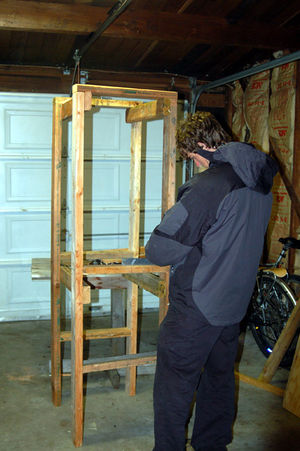
Dehydrating food has been a long standing practice of cultures all over the world. With many cultures dehydrating food by placing it on roof tops or ground to dry. This unfortunately has the high risk of contamination from dirt, pest,and unfavorable weather. By creating a dehydrator which has covering it is less liking that the food content will be exposed to contaminants.
The principle behind dehydrating is taking out the excess water in the fruit, vegetable, or meat, as a means of preserving and storing. By taking out the water content it limits the medium that harbors bacteria or fungi. Dehydrating food allows it to have a storage life of multiple years.
Solar dehydrators work by creating a consistent warm air flow through a cabinet containing the agricultural products on various shelfs. Solar energy is absorbed in one chamber and transformed into Infrared heat by a black backing, the heat warms air in the heating chamber and induces a convection of of air through the cabinet, effectively passing warm air through the foodstuffs and greatly reducing their moisture content. It is simple in principle but profound in action.
Project Requirements
Construct a working solar powered food dehydrator for the Ed Farm to use this season. THis project will be used as a educational tool for community members and farmers alike. This solar dehydrator will be an example of how to build your own food dyhydrator, encouraging poeple to be more self sufficiate and energy concouse.
Criteria
- Durability
- Able to withstand weathering and continual use
- Educational Aspect
- Informative for users and visitors of the farm
- Expediency of Drying
- Quick and complete removal of moisture from products with time constraints of rotting
- Dehydrating Capacity
- Accommodates loads of agricultural products from the farm not gathered by CSA members
- Appropriatness of Material
- Construction Materials come from sustainable sources (reused, reconditioned)
- Functionality
- Performs to the liking of the farmers
- Mobility
- Lightweight and portable in case of moving needs or for tracing the sun.
Design
We will be emulating a simple upright design used by CCAT several years ago and proven to work in the area. The Energy recieving component will be slightly larger than the one CCAT had. The structure will be 6 feet tall, and have about 30 square feet of shelving space for produce.
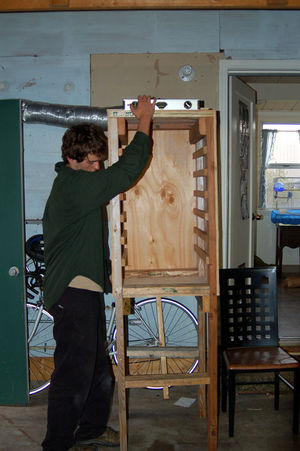
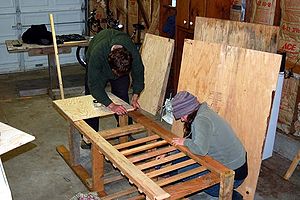
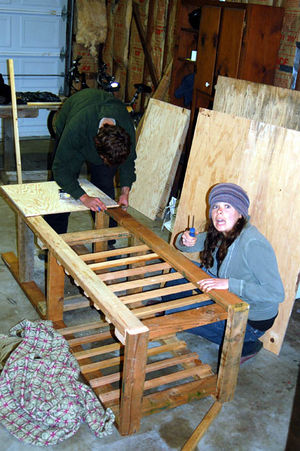
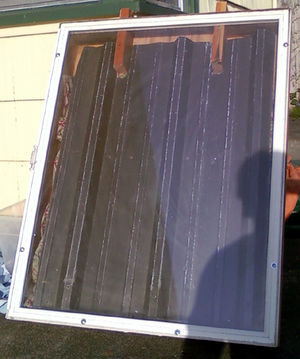
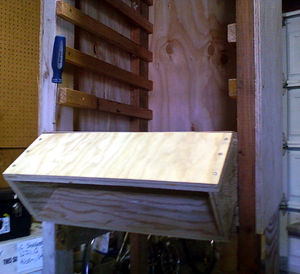
Costs
Table 1. Solar Food Dehydrator (Materials) Cost
Testing ResultsIt is far to early to draw conclusions. | |||||||||||||||||||||||||||||||||||||||||||||||||||||
Table 3. Solar Food Dehydrator Efficacy Data
| |||||||||||||||||||||||||||||||||||||||||||||||||||||
Table 4. Electric Food Dehydrator Drying Times
| |||||||||||||||||||||||||||||||||||||||||||||||||||||
Design Consideration
Literary Review
Sources
- MacDonald college of McGill University, Brace Research Institute. a survey of agriculture dryers. Quebec: Macdonald college of McGill University, 1975.
- Riordan, Bruce, and Michael Anderson. The Solar Home Book, heating, cooling and designing with the sun. unknown: Brick House Pub. Co., Inc., 1976.
- Valdez, Annie, and Maria Valdez. A Cookbook for Building a Solar Food Dehydrator. Alamosa Colorado: O&V Printing Inc, 1977.
- Macdonald college of McGill University, Brace Research institute. How to make a solar Cabinet Dryer For Agricultural Produce. Quebec: Brice Research Institute, Macdonald college of McGill University, 1975.
- Riordan, Bruce, and Michael Anderson. The Solar Home Book, heating, cooling and designing with the sun. unknown: Brick House Pub. Co., Inc., 1976.
<layout name="Project" />